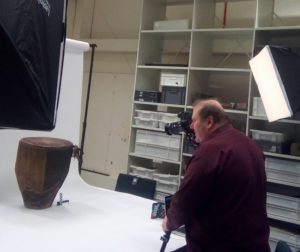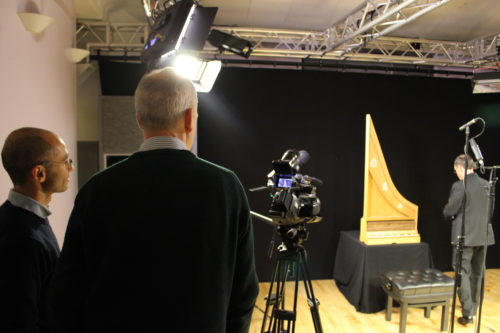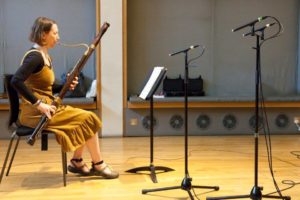
Development of the MINIM-UK project has been supported by the Higher Education Funding Council for England (HEFCE) Catalyst Fund.
The project is supported by the Royal College of Music until at least 2022.
Cataloguing standards
The development of a standard for object records in the database, and for cataloguing objects without previous descriptions, represented one of the key challenges for the MINIM-UK project.
There were many aspects to consider. How do we ensure relevant information is included? How do we acquire the right amount of information within the time limitations for cataloguing fieldwork? Previous work in the field of organology (the scientific study of musical instruments) and the work completed by the MIMO project, provided ideal foundations to develop a standard.
As a starting point, we made use of the methodological guideline developed in Cataloguing Standards for Instrument Collections.1 This publication sets out objectives, principles and procedures for a cataloguing process, and additionally provides appropriate fields for object information.
Considering the need to quickly and efficiently gather information in time-limited scenarios, we identified fourteen primary fields for each record. Many of these are common descriptors for objects held in cultural institutions (object name, place of origin, maker), while others are particularly pertinent to musical instruments (nominal pitch, Hornbostel-Sachs classification).
What about the data structure for each record? A schema is already available thanks to the work of the MIMO project,2 who developed a branch of the Lightweight Information Describing Objects (LIDO) XML schema.3 LIDO was developed to describe museum objects across many types, and is now a common framework for sharing of object information. MIMO added certain specificity to ensure mandatory information about musical instruments is given.
The MIMO Vocabulary provides a multi-lingual thesaurus for the classification of musical instruments, and was implemented into the cataloguing standards to provide an authoritative taxonomy of English instrument names.4
By combining the information of these resources, the standards have developed into descriptors for fields of information which can be populated through cataloguing or data harvesting. The cataloguing standards and record frameworks for musical instruments in the database have been published, providing support for the first steps in data mapping and transformation.
For the photography of musical instruments, MINIM-UK cataloguers followed the MIMO Digitisation Standard wherever practical. Museums are encouraged to use these standards for the photography of their own musical instruments, as they provide a framework for preferred positions and views of the photographed subject.
Cataloguing visits
Project cataloguers visited and assisted collections across the UK to support their addition to the MINIM-UK database, and to help improve or create documentation about their instrument collections. We thank the following bodies for the support provided to our cataloguers during their visits.
| Cliffe Castle Museum | Kirklees Museums and Galleries | Royal College of Music |
| Colchester and Ipswich Museums | Manx National Heritage | Royal Pavilion Museums Brighton |
| College of Piping | Milton Keynes Museum | Russell-Cotes Art Gallery & Museum |
| Cyfarthfa Castle Museum | Museum of Archaeology and Anthropology, University of Cambridge | Museum of Army Music |
| Glenesk Folk Museum | National Army Museum | Powell-Cotton Museum |
| Gloucester Life | National Museum of the Royal Navy | Stroud District (Cowle) Museum |
| Horniman Museum & Gardens | Powell-Cotton Museum | Swindon Museum & Art Gallery |
| Inns of Court and City Yeomanry Museum | Royal Botanic Gardens, Kew | University of Aberdeen Museums |
| International Anthony Burgess Foundation | Royal Conservatoire of Scotland | Warrington Museum |
|
|
|
Our cataloguers visited over 25 collections, travelling more than 10,000 miles in the UK. Their work led to the digitisation of over 4,000 instruments that were not available online before, including, for example:
- An extremely rare flute made from narwhal ivory.
- An upright piano with an unusual curved keyboard design.
- Instruments used by the author and composer Anthony Burgess, including a previously unknown English guitar.
- A 16th century decorated Italian virginal.
- Bone flutes reputed to be from the Dark Ages.
- A late 17th century North African lute.
- A rare 1756 cello by Aberdeen maker Robert Duncan.
- Extensive new documentation and photography at the Museum of Archaeology & Anthropology (University of Cambridge), and Royal Pavilion Museums Brighton.
Directory of collections
The vast musical instrument heritage of the UK is preserved in collections ranging from National museums to remote country mansions. The early stages of the MINIM-UK co-ordinated research into collections across the country, a vital step to ascertain where exactly musical instruments, or information about them, existed.
Although collection directories already exist, the last major publication on UK institutions holding musical instruments was in 1990. The preparation of a new edition of Grove Dictionary of Musical Instruments also stimulated the development of the Sigla for Musical Instrument Collections.5
These and other sources proved valuable to develop a new directory: the Museum Association lists music collections in its own registry, for example.6,7,8. Resources such as local authority websites, directories of military, ethnography, and social history collections, and listings of national heritage trusts have helped ensure a wide scope of institutions were researched.9 Additional thanks are due to the project Steering Group and to Professor Arnold Myers for comments and corrections, and for important information about individual collections.
One of the fascinating and exciting aspects found as the directory developed is how music and the development of musical instruments permeates throughout a wide range of collections and collection types, such as social history, decorative arts, design, military history, ethnography, religion, and beyond. When the project started, previously published directories pointed to around 100 collections existing in the UK. We know now that the actual figure is higher, at over 300.
The collection profiles in MINIM-UK now act as a new directory, which will evolve as the project develops further.
Instrument recordings
|
|
|
Performance of repertoire on historic instruments gives a rare insight into musical experiences of the past. The MINIM-UK project commissioned professional audio and video recordings of instruments including:
- Examples of historic keyboard instruments at the Royal College of Music Museum, recorded by the RCM Studios.
- String, wind, and percussion instruments at the Royal Academy of Music Museum.
- A harpsichord at the Horniman Museum.
Additional audio and video recordings were created during project cataloguing visits, where instruments were deemed suitable for performance by both our cataloguers and curatorial teams.
Archival recordings from other collections have also been harvested by the project, and are available to see and hear through individual instrument records.
Instrument browser
MINIM-UK is a key source for the exploration of historic musical instruments held in the United Kingdom?s publically-accessible collections, with the aim to support research, education, and those with a general interest in music and music history. Users can employ date and geographic filters to aid their research. Additional specialist filters for instrument classifications and makers provide a specialist level of filtering, enabling a range of discoveries:
- Instruments from more than 120 countries, and over 500 major conurbations.
- More than 800 unique types of musical instruments, from accordions to zurnas.
- Instruments made from 2600BC to the present day.
- Objects made by thousands of different instrument makers.
References and further reading
- Myers, A. (1989). Cataloguing Standards for Instrument Collections.?CIMCIM Newsletter, No. XIV, pp.14-28. Available online at: http://www.euchmi.ed.ac.uk/itnXIVc.html
- Musical Instrument Museums Online. Available online at: http://mimo-international.com/mimo
- What is LIDO. Available online at: http://network.icom.museum/cidoc/working-groups/lido/what-is-lido/
- MIMO Vocabulary. Available online at: http://www.mimo-db.eu/index.html
- Myers, A. (2015). Sigla for Musical Instrument Collections. Available online at: http://homepages.ed.ac.uk/am/iws.html
- Museums Association. Find a Museum. Available online at: http://www.museumsassociation.org/find-a-museum
- Bevan, C. (1990). Musical Instrument Collections in the British Isles. Winchester: Piccolo Press.
- Jenkins, J. (1977). International Directory of Musical Instrument Collections. Buren: Frits Knuf.
- Gratitude is expressed for the work of Héléne la Rue on the National Musical Instrument Register and Database. The premise and inspiration of Lyndesay Langwill’s Index, which was to list known museum and collection instruments by their creator, has also been an influence on project research.




